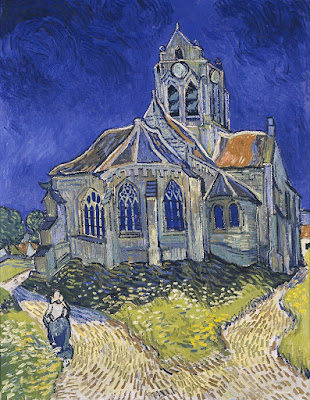In the end, there’s an audience for nearly everything. The trick is finding it.
 |
|
The Red Vineyard, 1888, Vincent van Gogh. It was sold to Anna Boch for 400 francs in 1890. Courtesy Pushkin Museum, Moscow.
|
“I like paintings with buildings in them,” a non-artist friend told me yesterday. “Scenes are beautiful, and I appreciate them, but if there’s a few cottages by the shore I can imagine the lives of the people who live in them forever. It’s more interesting over the long haul.”
I was driving at the time (with Bluetooth, of course) back from picking up paintings at What’s Nude in Boothbay Harbor. I try to send them two paintings every year. A naked person on the living room wall isn’t to everyone’s taste, but every once in a while, someone will express an interest in one and off it goes.
In the evening, someone else mailed me two images of really odd paintings. “My friend does some stra-a-a-a-nge art,” she said. I couldn’t disagree, and yet they were on their way to a juried show.
 |
|
Ward in the Hospital in Arles, 1889, Vincent van Gogh, courtesy Oskar Reinhart Collection.
|
Recently, I wrotethat all art criticism is by nature subjective. That’s never truer than in a particular gallery or show. There, a single juror usually holds sway. There are also factors about which we’ll never know, like where we live, our subject matter, and the media in which we work… or if we’ve somehow offended the gallerist or organizer in the past.
It’s very easy to lose your nerve after a string of rejections, especially in the dead of winter when most show apps are made. Keep on persevering. One never knows what the outcome will be.
“A lot of what we sell is popular because it’s pretty and unchallenging,” says a fictional gallerist in a so-so novel I’m reading. “I do well out of those artists and that means I can keep stocking artists whose output is actually meaningful.”
Wouldn’t we all like to meet such a gallerist in real life! But the truth is that accessible, pretty, and unchallenging does sell most quickly.
 |
|
The Round of the Prisoners (after Doré), 1890, Vincent van Gogh. Courtesy Pushkin Museum, Moscow.
|
‘I, for my part, know well enough that the future will always remain very difficult for me, and I am almost sure that in the future I shall never be what people call prosperous,’ Vincent van Gogh wrote to his brother Theo.
Legend has it that Van Gogh sold only one painting in his lifetime, to fellow artist Anna Boch. This is not true. Vincent sold several works, but his income from painting was never sufficient to support him.
“Nothing would help us to sell our canvases more than if they could gain general acceptance as decorations for middle-class houses. The way it used to be in Holland,” Theo van Goghwrote back.
 |
|
The Church at Auvers, 1890, Vincent van Gogh. Musée d’Orsay, Paris.
|
Theo was an influential art dealer in his own right, and was able to further the careers of Impressionists like Claude Monet and Edgar Degas. But championing his brother’s ‘strange’ artwork was beyond even him.
Of course, the great barrier was that Vincent was painting farther into the future than his peers. His work wasn’t accessible to the contemporary Parisian in a way that Monet’s and Degas’ were. He had an authentic voice, and it got in the way of his sales.
In the end, there’s an audience for nearly everything, but the great career dilemma for the painter is to find it.
